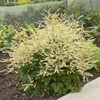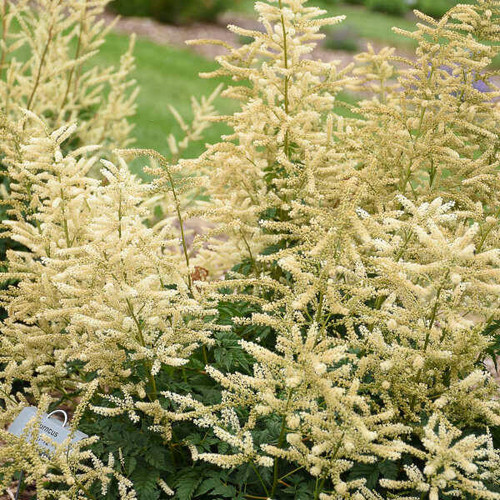Product Description
Aruncus 'Chantilly Lace' PP30740 CPBR6259 (30)ct Flat
Common Name: Goat's Beard
'Chantilly Lace' will be shorter if grown in full sun, closer to 24" tall, than if grown in shade or a sun-filtered area, where it will grow to a height of 30-32".
With the addition of 'Chantilly Lace' to the Proven Winners® program, you can be well on your way to a complete shade garden lineup! This part shade-loving plant produces beautiful sprays of lacy, cream-colored flowers in late spring to early summer. It is very floriferous when it's in bloom, completely covering the deep green foliage. Goatsbeard is similar in appearance to Astilbe in the garden, but it is more drought tolerant.
Though Aruncus tends to be a slow-grower the first couple of seasons, once it is established it puts on a fabulous show year after year. Make sure it has plenty of room to grow when you first plant it; transplanting this species is a very difficult task. This species is native to North America.
Goat's Beard grows best in moist, humus-rich soils. In northern climates, it can be grown in full sun if provided with adequate moisture. In southern zones, however, it prefers partial or full shade. When grown in deep shade, plants tend to have a more open habit and bloom sparsely. Insects and diseases don't seem to bother this plant.
Height: 30.0-32.0 Inches
Spread: 40.0-48.0 Inches
Hardiness Zones: 3,4,5,6,7
Flower Color: White Shades
Foliage Color: Green shades
Full Sun (> 6 hrs. Direct Sun) to Full Shade (< 4 hrs. Direct Sun)
Average to Consistent Water Needs
Fertile Soil Quality
Bloomtime: Early Summer - Midsummer
Bee Friendly
Deer Resistant
Growth Rate: Medium
Border Plant, Container, Cut Flower, Cut Foliage, Mass Planting
Add a Touch of Elegance and Drama to Your Shade Garden with 'Chantilly Lace' Goat's Beard!
Aruncus 'Chantilly Lace' is a stunning perennial that brings a touch of airy elegance to shady gardens. This graceful plant boasts large, fluffy plumes of creamy-white flowers that rise above its fern-like foliage, creating a beautiful and dramatic focal point.
'Chantilly Lace' is a cultivar of Goat's Beard, known for its refined and elegant appearance. Its Astilbe-like foliage is a deep green, creating a lush backdrop for the spectacular floral display. In early to mid-summer, the plant produces an abundance of feathery plumes, packed with tiny creamy-white flowers. These plumes create a cloud-like effect, adding a touch of ethereal beauty to the shade garden. 'Chantilly Lace' is a relatively large perennial, making a bold statement wherever it is planted.
- Mature Size: 2-3 feet tall, 3-4 feet wide
- Flower Color: Creamy white
- Bloom Time: Early to mid-summer
- Foliage: Deep green, fern-like
- Growth Habit: Clump-forming, upright
- Light Needs: Full sun to part shade (tolerates full shade, but blooms best with some sun)
- Soil Needs: Fertile, moist, well-drained soil
- Hardiness Zones: 3-7 (USDA)
- Special Features: Showy flowers, attractive foliage, deer resistant, relatively drought tolerant
Planting:
- Timing: Plant in spring or fall for best results.
- Location: Choose a location with full sun to part shade. 'Chantilly Lace' can tolerate full shade, but it will produce more flowers with at least a few hours of sunlight per day.
- Soil Preparation: Amend the soil with compost or other organic matter to improve drainage and fertility.
- Spacing: Space plants 3-4 feet apart to allow for their mature size.
- Planting Depth: Plant the crown (where the stems emerge from the roots) at the same level as the soil surface.
- Watering: Water thoroughly after planting and regularly until it is established.
Care:
- Watering: 'Chantilly Lace' prefers consistently moist soil but can tolerate some dryness once established. Water regularly during dry periods.
- Fertilizing: Apply a balanced fertilizer in spring to promote healthy growth and flowering.
- Pruning: Deadhead (remove spent flower plumes) after blooming to tidy the plant's appearance and encourage reblooming. You can also cut back the foliage in late fall or early spring.
- Dividing: Divide clumps every few years in spring or fall to maintain vigor and prevent overcrowding.
- Pest and Disease Control: 'Chantilly Lace' is generally pest and disease free.
Uses in the Garden:
- Shade Gardens: A perfect addition to shade gardens, adding a touch of elegance and drama.
- Woodland Gardens: Thrives in woodland settings, complementing other shade-loving plants.
- Borders and Edging: Creates a beautiful backdrop for shorter perennials in borders.
- Mass Plantings: Plant in groups for a stunning display of fluffy white plumes.
- Containers: Can be grown in large containers, adding a vertical element to patios and balconies.
- Cut Flowers: The flower plumes make excellent cut flowers for fresh or dried arrangements.
Bring a touch of airy elegance to your shade garden with Aruncus 'Chantilly Lace'!
Thirty (30) plants per flat (or tray). Approximate Plug Measurements: 3in deep x 2in wide.
Other Details
The most important part of the plant is its root system. Healthy roots are the foundation of a healthy, vibrant plant. The type of plug container used is based on the specific needs of the plants. Perennials offered as bare root traditionally perform better when planted as bare root.Planted in a specialized mix, potted plants have well established root systems. Top growth stage will vary depending on the current life cycle and time of year when shipped. In Winter and early Spring dormant plants may be shipped. Dormant plants may be planted right away, even before the last frost date.
Most bare root varieties are field grown for at least one season, though Hemerocallis and Hosta are grown for two seasons. The bulk of the soil is removed during the harvesting process and the tops of most varieties are trimmed back to the crown. They are graded, packed in shredded aspen or sphagnum moss and stored in freezers until ready to be shipped.
See our Container Sizes and Bare Root Perennials pages for more information.
Plant information and care is provided in the Overview section, Plant Genus Page and general information is provided in the Planting Care & Guides. Additional questions can be asked on each Plant page.
Plant Spacing: Using the maximum mature spread or width of a plant to guide spacing, ensures space to grow to full size. To fill an area sooner, plant them closer together. Just remember, future thinning or transplanting may be needed.
Water: Keep a close eye on newly planted perennials, especially throughout the first growing year. Most early plant loss is due to too much or too little water!



















